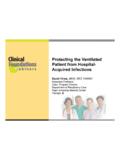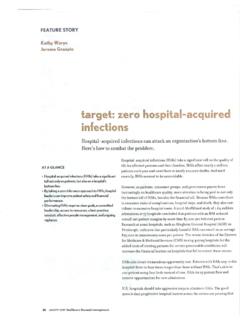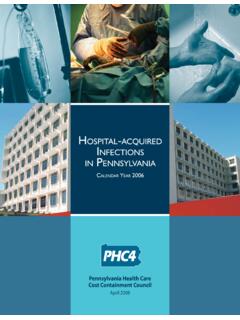Transcription of Epidemiology of healthcare acquired infection – …
1 Indian Journal of Basic and Applied Medical Research; September 2014: , Issue- 4, P. 46-63. Epidemiology of healthcare acquired infection An Indian perspective on surgical site infection and catheter related blood stream infection V Ramasubramanian1, Vivek Iyer2*, Sandeep Sewlikar3 and Anish Desai4. 1 Sr Consultant Infectious Diseases, HIV & Tropical Medicine, Apollo hospitals, Chennai Adjunct Professor of Infectious Diseases & Consultant, Sri Ramachandra Medical College & Research Institute (DU). Adjunct Associate Professor of Infectious Diseases, University of Queensland. Adjunct Associate Professor of Infectious Diseases, MGR Medical University 2 infection Prevention Specialist, Johnson and Johnson Limited, Mumbai 3 Manager Clinical Affairs, Johnson and Johnson Limited, Mumbai 4 Director Medical Affairs and Clinical Operations, Johnson and Johnson Limited, Mumbai * Corresponding Author: Dr.
2 Vivek Iyer ; Email: Date of submission: 08 June 2014 ; Date of Publication: 15 September 2014. ABSTRACT. healthcare acquired infections or hospital acquired infections (HAIs) are amongst the most common complications of hospital care, leading to high morbidity and mortality. While WHO estimates about 7-12% HAI burden in hospitalized patients globally, the figures from India are alarming, with an incidence rate varying from 11% to 83% for different kinds of HAIs. The article reviews literature and data for HAIs from India, with particular focus on surgical site infections (SSIs) and catheter related blood stream infection (CRBSI). The profile of SSIs and CRBSIs in India with a relative context to the relevant global data has been discussed.
3 Key words: hospital acquired infection , Surgical site infection , Catheter related blood stream infection , pathogens INTRODUCTION. healthcare acquired infection , alternatively also make out whether an infection was acquired outside called hospital acquired infection ' (HAI), or the hospital or inside a specific healthcare set up (4). nosocomial infection ' refers to the infection The current clinical review highlights published occurring in patients after admission at the hospital literature on Epidemiology of HAI, surgical site for a reason other than that infection ; an infection that infection (SSI) and catheter related blood stream was neither present nor incubating at the time of infection (CRBSI) in India.
4 The literature search was admission. This includes infections acquired in the performed using Medline database, PubMed website hospital but appearing after discharge, and also and general search engines. The citations published occupational infections among staff of the facility (1, in last two decades, highlighting incidence rate, 2, 3). As a general timeline, infections occurring prevalence rate and economic burden were more than 48 hours after admission are usually considered for the review. Total 18 studies were considered hospital acquired . The hospital infection shortlisted for the review. Most of them were Society of India (HISI) finds the latter justified in the prospective observational studies and one study was Indian scenario, as most of the time it is difficult to single day point prevalence study.
5 46. P ISSN: 2250-284X , E ISSN : 2250-2858. Indian Journal of Basic and Applied Medical Research; September 2014: , Issue- 4, P. 46-63. HAIs are likely to be the most common complication developing countries including India revealed an of hospital care. World Health Organization (WHO) overall rate of HAI corresponding to estimates these infections to occur among 7-12% of infections per 1000 ICU days (7). In 2007, the the hospitalized patients globally, with more than INICC conducted a prospective surveillance in 7. million people suffering from infectious Indian cities to determine the rate of HAI, complications acquired in the hospital at any time (1, microbiological profile, and related aspects in India.)
6 Data for a total of 10,835 patients hospitalized for a 2, 5). A survey amongst 55 hospitals of 14 countries total of 52,518 days from 12 ICUs at 7 different representing the 4 WHO regions (Europe, Eastern hospitals were evaluated. This study benchmarks Mediterranean, South-East Asia and Western Pacific). HAI rates in Indian ICUs against international showed that of hospital patients had nosocomial standards. An overall HAI incidence rate of infections (1). HAIs have highest prevalence in corresponding to infections per 1000 ICU-days intensive care units (ICUs), and in acute surgical and was reported (9). Lately, there are increasing reports orthopaedic wards (1). Moreover, the burden of HAIs from different parts of the country revealing varying is higher in developing countries (6).
7 The estimated HAI incidence rates across various healthcare setups. prevalence of HAIs in the United States (US) is In India, major health services are given by corresponding to infections per 1000 patient- government hospitals. Unfortunately, very limited days; while that in Europe is reported to be HAI data is available from government hospitals to corresponding to a cumulative incidence of assess the actual burden of HAI in India. Data on episodes per 1000 patient-days (3). A Multicenter, HAI prevalence in India over the last few years has prospective cohort surveillance of device-associated been summarized in Table 1. The table also reflects infection by the International Nosocomial infection an increasing trend in HAI incidence across India Control Consortium (INICC) in 55 ICUs of 8 over the last decade.
8 Table 1: Incidence of hospital acquired infections in India Source Total Patients Patients with HAI HAI rate# infections per (N) HAI (n) number of 1000 patient episodes days Mehta 2007 (9) 10,835 ns 476 Taneja 2004 (14) 71 71 59 Habibi 2008 (15) 182 62 95 Kamat 2008 (16) 498 103 169 34% Shalini 2010(13) 355 97 ns Ns Datta 2010* (17) 429 105 125 Ns Sood 2011*(18) 435 Ns 19 *. Ramana 2012 (19) 642 266 ns 41% Ns 47. P ISSN: 2250-284X , E ISSN : 2250-2858. Indian Journal of Basic and Applied Medical Research; September 2014: , Issue- 4, P. 46-51. N = total number of patients in the study, n = number of patients with HAI, ns = not specified in the source, # where episodes of HAI are unavailable, this column presents HAI percentage, * only device associated infections included.
9 Figure 1: HAI rate reported in various Indian publications 41%. 34%. 0. HAI Rate HAIs account for major causes of death, functional infections per year, the estimated added healthcare disability, emotional suffering and economic burden expenditure is in excess of $2 billion per year; while among the hospitalized patients (2, 3). The crude the direct medical cost of HAI ranged from $28-45. mortality rate in the INICC survey across developing billion (3). In the UK, a patient with HAI spends countries including India ranged from to times longer in hospital , incurring additional costs of (7). The increased length of stay for infected 3000 more than an uninfected patient (11).
10 A. patients is the greatest contributor to cost. It is retrospective case-control, cost utility analysis in a suggested that the increased length of stay varies tertiary care Indian hospital reported a significantly from 3 days for gynaecological procedures to longer total hospital stay averaging to days in days for orthopaedic procedures. The increased use patients with bacteraemia, accompanied with of drugs, the need for isolation, and the use of significantly longer ICU stay of days and a additional laboratory and other diagnostic studies significantly higher attributable mortality of 54%; all also contribute to costs. There are also indirect costs these costing significantly more (average US.)



















